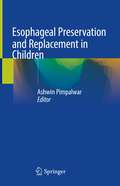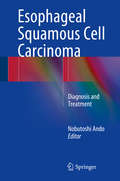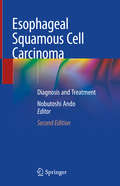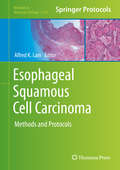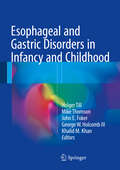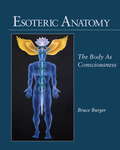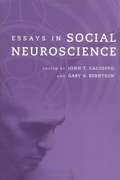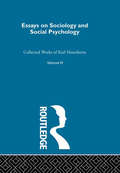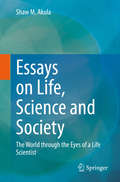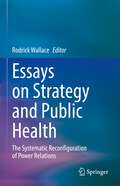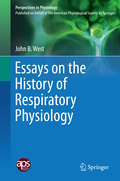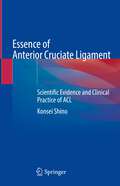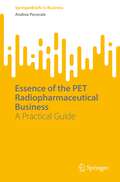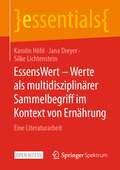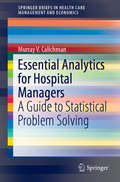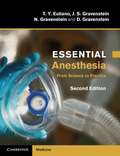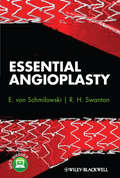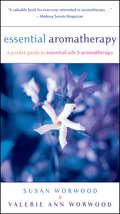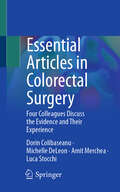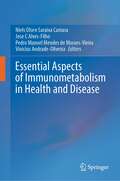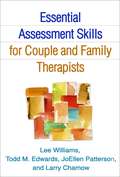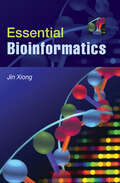- Table View
- List View
Esophageal Preservation and Replacement in Children
by Ashwin PimpalwarThis book provides a comprehensive, state-of-the art, evidence-based review of esophageal preservation and replacement and serves as a valuable resource for clinicians, surgeons and researchers with an interest in this field. The text reviews in detail the embryology, anatomy and physiology of the esophagus relevant to esophageal replacement. The indications, advantages, disadvantages, complications and long-term outcomes of all techniques available are also discussed. The latest advances in this field including the laparoscopic and thoracoscopic techniques are included with detailed descriptions and figures. Recent advances in tissue engineering techniques for manufacturing a neo esophagus are also discussed in detail. All chapters are written by experts in their fields and includes the most up to date evidence-based data available.Esophageal Preservation and Replacement in Children is one of its kind and serves as a very useful resource for surgeons and researchers all over the world. It provides a comprehensive summary of the current status of esophageal preservation and replacement and all the recent advances in this field.
Esophageal Squamous Cell Carcinoma
by Nobutoshi AndoEsophageal cancer causes an estimated 386,000 deaths worldwide and is the sixth most common cause of death for men. The background characteristics of esophageal cancer treatment are markedly different between Asian and Western countries, however. In tumor histology, squamous cell carcinoma associated with smoking and alcohol consumption is overwhelmingly prevalent in Asia, whereas adenocarcinoma associated with Barrett's metaplasia is markedly prevalent in the West. In Asia, especially in Japan, the key persons who play important roles in the management of esophageal cancer patients are surgeons; in the West those roles are filled by medical and radiation oncologists as well as surgeons. The philosophy of surgeons regarding cancer surgery varies from locoregional to local tumor control, particularly in focusing on lymph node dissection. Physicians' approach to surgical adjuvant therapy differs, therefore, between Asia and the West. Considering these East-West differences in esophageal cancer treatment, the currently available results of Western evidence should not be considered directly applicable to esophageal cancer in Asia In this book, the authors discuss the knowledge base in Japan in terms of treatment of esophageal squamous cell carcinoma. Since this volume contains a wide spectrum of current information and addresses topics surrounding the treatment of patients with esophageal squamous cell carcinoma, it is highly relevant to Asian physicians and researchers as well as to their counterparts in the West.
Esophageal Squamous Cell Carcinoma: Diagnosis and Treatment
by Nobutoshi AndoThis is the second edition of the book, covering a wide spectrum of the latest information relevant to diagnosis and treatment of esophageal squamous cell carcinoma (ESCC). In recent years the incidence rate of esophageal cancer has been increasing; however, the background characteristics of the cancer treatment are significantly different between Asian and Western countries. In tumor histology, ESCC associated with smoking and alcohol consumption is overwhelmingly prevalent in Asia, whereas adenocarcinoma associated with Barrett’s metaplasia is remarkably prevalent in the West. In Asia, especially in Japan, surgeons play a significant role in the management of esophageal cancer patients, while medical and radiation oncologists as well as surgeons are important in the West. Considering these East–West differences in management of esophageal cancer, evidence originating in Asia should be more widely disseminated globally. The contributing authors, who have great expertise in their areas of specialization, discuss details in terms of treatment of ESCC, including basic science, diagnosis, surgery, other treatment modalities, Japanese guidelines, and also valuable experiences from other Asian countries. Accordingly, this excellent collection of texts benefits not only oncologists, but all medical and biological researchers involved in the latest ESCC research.
Esophageal Squamous Cell Carcinoma: Methods and Protocols (Methods in Molecular Biology #2129)
by Alfred K. LamThis volume provides current management and research protocols on oesophageal squamous cell carcinoma. Chapters guide readers through methods on clinical and pathological diagnostics, translational research for oesophageal squamous cell carcinoma, in vitro assays, liquid biopsy for cancer DNA and circulating tumour cells, genomic analysis, mi-RNAs, and proteins. Written in the highly successful Methods in Molecular Biology series format, chapters include introductions to their respective topics, lists of the necessary materials and reagents, step-by-step, readily reproducible laboratory protocols, and tips on troubleshooting and avoiding known pitfalls. Authoritative and cutting-edge, Esophageal Squamous Cell Carcinoma: Methods and Protocols to ensure successful results in the further study of this vital field.
Esophageal and Gastric Disorders in Infancy and Childhood
by Mike Thomson Holger Till John E. Foker George W. Holcomb III Khalid M. KhanEsophageal anomalies and disorders in infancy and childhood include a wide spectrum of different diseases. These range from emergencies immediately after birth such as esophageal atresia (EA), necessitating an experienced team of neonatologists and pediatric surgeons, up to gastro-esophageal reflux disease in elder children, necessitating the pediatric gastroenterologist and visceral surgeon. In the last few years some fascinating pediatric surgical techniques have evolved, such as the thoracoscopic correction of EA or the FOKER technique for elongation in cases of long-gap, EA. Prof. Foker has developed this special traction technique and is the world's leading expert in long-gap EA.
Esoteric Anatomy: The Body as Consciousness
by Richard Gordon Mathaji Vanamali Bruce BurgerEsoteric Anatomy offers a spiritual approach to massage, bodywork, and somatic psychology, demystifying an ancient transpersonal model for understanding energy in nature and working with consciousness in the healing arts.
Essays In Social Neuroscience
by John T. Cacioppo Gary G. BerntsonLeaders in the field provide an introduction to the multidisciplinary collaborations of social neuroscience.
Essays Soc & Social Psych V 6
by Karl MannheimFirst published in 1969. Routledge is an imprint of Taylor & Francis, an informa company.
Essays on Blindness Rehabilitation in Honor of Thomas J. Carroll: A Festschrift
by John F. MuldoonThe author of the articles in this book has given us an excellent assessment of Father Carroll's concepts and the viability of those concepts today. Moreover, they have provided us with a look at the man behind the ideas.
Essays on Life, Science and Society: The World through the Eyes of a Life Scientist
by Shaw M. AkulaThis collection of nine essays provides an entertaining and thoughtful glimpse into trending topics in our lives. The author, Dr. Akula, tackles questions on life, science, and society from a biologist’s perspective. The book covers a broad range of topics, including common questions with complex answers intermixed with some religion and humor, making it a great read to give your brain cells a boost. The field of Science is massive - in fact, it’s the size of the universe, which means picking just a few topics to discuss is no mean feat. This book is a start, but there is more to come as Dr. Akula explores various subjects to discuss and shed new light on. This collection of essays will appeal to scientists, and to lay readers with an interest in the natural sciences. Its goal is to ensure that science isn’t accessible to only a few people, but is instead disseminated to many. After all, a Smart World is the key to a Better Tomorrow and a Brighter Future.
Essays on Strategy and Public Health: The Systematic Reconfiguration of Power Relations
by Rodrick WallaceThis book is a collection of essays that explore commonalities and contrasts between strategy in armed conflict and strategy in public health. The first part uses the asymptotic limit theorems of information and control theories to study strategy as an exchange of messages between adversaries, in the context of underlying power relations. The ‘messages’ to be exchanged are constructed from an ‘alphabet’ of tactics available to each contender, in a large sense. The second part of the book explores four case histories from this perspective, ranging across agribusiness-generated pandemics, through tuberculosis and COVID-19. The final chapter attempts a strategic synthesis applicable more specifically to public health than to the remarkably – and disturbingly -- close parallel of armed conflict. Taking a unique approach to public health tactics and strategy this volume will be of interest to social epidemiologists, public health economists, public policy scientists, as well as public health researchers and practitioners.
Essays on the History of Respiratory Physiology
by John B. WestThis book consists of 23 essays about prominent people and events in the history of respiratory physiology. It provides a first-hand chronicle of the advancements made in respiratory physiology starting with Galen and the beginnings of Western physiology. The volume covers every aspect of the evolution of this important area of knowledge: pulmonary circulation, Boyle's Law, pulmonary capillaries and alveoli, morphology, gas exchange and blood flow, mechanics, control of ventilation, and comparative physiology. The book emphasizes societal and philosophical aspects of the history of science. Although it concentrates on physiology, it also describes how cultural movements, such as The Enlightenment, shaped the researchers discussed. This book is published on behalf of the American Physiological Society by Springer. Access to APS books published with Springer is free to APS members.
Essence of Anterior Cruciate Ligament: Scientific Evidence and Clinical Practice of ACL
by Konsei ShinoThis monograph offers an in-depth understanding of the scientific basis of anterior cruciate ligament treatment (ACL) and clinical application based on the author's more than forty-year experience. Starting with basic science such as anatomy and biomechanics, the following chapters explain the practical diagnostic methods using manual examination and imaging. It then provides reconstructive surgery techniques on specific cases, postoperative rehabilitation for early and safe return to sports, and detailed evaluation methods with a view to prognosis. It also offers a rationale for evidence-based treatment strategies and evaluation of the treatment for further improvement. The supplemental information offers readers a revitalizing alternative to current methods. Essence of Anterior Cruciate Ligament – Scientific Evidence and Clinical Practice of ACL is a must-read for physicians, orthopaedic surgeons, physiotherapists, and athletic trainers to treat and rehabilitate patients.The translation was done with the help of artificial intelligence. A subsequent human revision was done primarily in terms of content.
Essence of the PET Radiopharmaceutical Business: A Practical Guide (SpringerBriefs in Business)
by Andrea PecoraleThis book explores the organizational and operational activities of real Positron Emission Tomography (PET) radiopharmaceutical manufacturing. Centered around the author’s professional experience, this book specifically explores: (1) the selection and preservation of operational and managerial personnel; (2) the alignment of production plans to consumer needs while still achieving financial goals; and (3) the positive and negative aspects of different operation management methods for direct and third-party production. The book offers a valuable reference for hospital managers, professionals and consultants interested or involved in developing a radiopharmaceutical facility/business or personalized medicine and special productions.
EssensWert - Werte als multidisziplinärer Sammelbegriff im Kontext von Ernährung: Eine Literaturarbeit (essentials)
by Karolin Höhl Jana Dreyer Silke LichtensteinIn den aktuellen Diskursen um die Transformation des Ernährungssystems sind Werte omnipräsent. Jedoch werden sie dabei nicht immer ausdrücklich kenntlich gemacht. Häufig kommt es zu Be- und Abwertungen von Handlungen und Denkweisen, teils unter Heranziehung dichotomer Ernährungsnormen. Doch die Transformation bedingt einen konsensuell getragenen Wertewandel, der u. a. über Empathie und Mäßigung Lösungswege ebnet und das Wohlergehen aller adressiert. Dafür sind objektive Beobachtungen ohne normative Direktiven notwendig. Die Intention des vorliegenden Textes war daher die Auseinandersetzung mit verschiedenen Konzeptionen von Werten unterschiedlicher Disziplinen, um Reichweiten und Grenzen verschiedener Auffassungen im Ernährungskontext zu erörtern. Zur Information: Dies ist ein Open-Access-Buch.
Essential Analytics for Hospital Managers: A Guide to Statistical Problem Solving (SpringerBriefs in Health Care Management and Economics)
by Murray V. CalichmanThis book provides practical applications of statistical and mathematical concepts to resolve common issues in hospital management. Each chapter discusses a key component of hospital operations, such as maximizing hospital profitability through pricing optimization, forecasting facility requirements from historical data, and determining optimal patient schedules to fully utilize hospital resources in order to eliminate over-crowding in the emergency department. Structured by the degree of mathematical complexity, this professional book utilizes problem-solving methodologies ranging from basic statistical concepts (means and standard deviations) to more advanced statistics (Poisson distributions and queuing theory). Concluding with computer applications and simulations, the practical examples will help hospital managers to optimally and innovatively make use of linear programming. The book’s main goal is to make hospital personnel more aware of the benefits of management science methodologies that are not usually employed in today’s hospitals.
Essential Anesthesia
by J. S. Gravenstein N. Gravenstein D. Gravenstein T. Y. EulianoEssential Anesthesia is a concise, accessible introduction to anesthetic practice. Now in its second edition, it provides a thorough overview of the science and practice of anesthesia. Part I describes the evaluation of the patient, the different approaches to anesthesia, and the post-operative care of the patient in pain. Part II introduces the essentials of physiology and pharmacology and their role in understanding the principles of anesthesia. The final part presents a step-by-step description of 14 clinical cases. These clinical vignettes give a very real introduction to the practicalities of anesthesia and will give the non-anesthetist physician an idea of how to prepare a patient for a surgical procedure. All chapters have been expanded and updated and an entirely new chapter on safety in healthcare has been added. This is the perfect introductory text for medical students, junior doctors and all operating theatre and critical care staff.
Essential Angioplasty
by R. H. Swanton E. Von SchmilowskiA vast choice of techniques and technology confronts today's interventional cardiologists, and those who are new to angioplasty need clear and practical guidance in order to develop good habits, avoid common pitfalls and complications, and become efficient and confident practitioners. This new book supplies a solid grounding in the basics of percutaneous techniques by providing selective, practical knowledge and a full range of useful tools and tips. Throughout, the authors follow the motto "keep it simple" and focus only on the information that will help the reader learn and master the relevant technique. The book is designed for ease of use in the cath lab or other situations where the reader needs to access information quickly.
Essential Aromatherapy: A Pocket Guide to Essential Oils and Aromatherapy
by Valerie Ann Worwood Susan WorwoodHere is a complete guide to aromatherapy, a modern healing technique with ancient origins. Essential Aromatherapy organizes essential oils into alphabetical listings, providing their profiles, applications, and the physical and emotional conditions that warrant their use. Also included are detailed treatments for a variety of ailments and special circumstances.
Essential Articles in Colorectal Surgery: Four Colleagues Discuss the Evidence and Their Experience
by Dorin Colibaseanu Michelle DeLeon Amit Merchea Luca StocchiThis book is an anthology of important articles that have influenced partner surgeons in a colorectal surgical practice. Following the citations of these articles, there is a formal critique by one individual partner, then the remaining partners add their perspective presented in the form of a conversation. The contributions will be constructed as a discussion but will also include references to additional contemporary articles pertaining to the topic at hand. At times, the conversation will result in complete agreement, but there are other times where there could be differences, which could be anticipated given the individual background, age and time in practice of each surgeon. Highlighted throughout are situations where the practice has changed for the better, as well as other situations that remain open for discussion. The breadth of colorectal surgery as a specialty is covered, including anorectal surgery, abdominal surgery, both open and minimally invasive, inclusive of both benign and malignant disease.
Essential Aspects of Immunometabolism in Health and Disease
by Niels Olsen Saraiva Camara Jose C Alves-Filho Pedro Manoel Mendes de Moraes-Vieira Vinicius Andrade-OliveiraImmunometabolism has emerged as an intersectional crossroad between metabolism and immune response. Over the past decade, it has become clear that most - if not all - immune cell functions are not separated from cellular metabolism. Although seminal works have addressed the metabolic fate of immune cells during differentiation and function, the physiological status of a given tissue is also dependent on the cell metabolism. The dialogue between immune cells and their microenvironment can also modulate cellular metabolism, which can trigger the onset and progression of a multitude of inflammation-mediated diseases. Thus, uncovering the specific characteristics of the metabolism in different immune cells types and in different conditions, can shed light into the molecular mechanisms of disease and help develop new drugs and therapeutic strategies to treat immune diseases.The edited volume Essentials aspects of Immunometabolism will give the readers a broad view on how metabolic pathways can influence many types of immune cells during activation, differentiation and function, in health and disease. Of note, the structure of the book was created thinking not only on the experienced immunologist but also on undergraduate and graduate students, physicians, and all members of the scientific community interested in this exciting field of research.
Essential Assessment Skills for Couple and Family Therapists
by Lee Williams Todd EdwardsShowing how to weave assessment into all phases of therapy, this indispensable text and practitioner guide is reader friendly, straightforward, and practical. Specific strategies are provided for evaluating a wide range of clinical issues and concerns in adults, children and adolescents, families, and couples. The authors demonstrate ways to use interviewing and other techniques to understand both individual and relationship functioning, develop sound treatment plans, and monitor progress. Handy mnemonics help beginning family therapists remember what to include in assessments, and numerous case examples illustrate what the assessment principles look like in action with diverse clients.
Essential Bioinformatics
by Jin XiongEssential Bioinformatics is a concise yet comprehensive textbook of bioinformatics, which provides a broad introduction to the entire field. Written specifically for a life science audience, the basics of bioinformatics are explained, followed by discussions of the state-of-the-art computational tools available to solve biological research problems. All key areas of bioinformatics are covered including biological databases, sequence alignment, genes and promoter prediction, molecular phylogenetics, structural bioinformatics, genomics and proteomics. The book emphasizes how computational methods work and compares the strengths and weaknesses of different methods. This balanced yet easily accessible text will be invaluable to students who do not have sophisticated computational backgrounds. Technical details of computational algorithms are explained with a minimum use of mathematical formulae; graphical illustrations are used in their place to aid understanding. The effective synthesis of existing literature as well as in-depth and up-to-date coverage of all key topics in bioinformatics make this an ideal textbook for all bioinformatics courses taken by life science students and for researchers wishing to develop their knowledge of bioinformatics to facilitate their own research.
Essential Biological Psychology (Essential Psychology)
by G Neil MartinThe Essential Psychology Series bridges the gap between simple introductory texts aimed at pre-university students and higher level textbooks for upper level undergraduates. Each volume in the series is designed to provide concise yet up-to-date descriptions of the major areas of psychology for first year undergraduates or students taking psychology as a supplement to other courses of study. The authors, who are acknowledged experts in their field, explain the basics carefully and engagingly without the over-simplification often found in introductory textbooks, at the same time providing the reader with insights into current thinking.Essential Biological Psychology is an accessible, well-illustrated and well-written account of the study of the role of the body in behaviour and the effect of behaviour on the working of the body. Covering all the major topics within biopsychology, and evaluating the most up-to-date findings, particularly within neuroscience and neuroimaging research, this textbook is essential reading for first and second level undergraduates taking courses in biological or physiological psychology as well as anyone studying courses in neuropsychology or behavioural neuroscience.
Essential Biomaterials Science
by David WilliamsThis groundbreaking single-authored textbook equips students with everything they need to know to truly understand the hugely topical field of biomaterials science, including essential background on the clinical necessity of biomaterials, relevant concepts in biology and materials science, comprehensive and up-to-date coverage of all existing clinical and experimental biomaterials, and the fundamental principles of biocompatibility. It features extensive case studies interweaved with theory, from a wide range of clinical disciplines, equipping students with a practical understanding of the phenomena and mechanisms of biomaterials performance; a whole chapter dedicated to the biomaterials industry itself, including guidance on regulations, standards and guidelines, litigation, and ethical issues to prepare students for industry; informative glossaries of key terms, engaging end-of-chapter exercises and up-to-date lists of recommended reading. Drawing on the author's forty years' experience in biomaterials, this is an indispensable resource for students studying these lifesaving technological advances.
